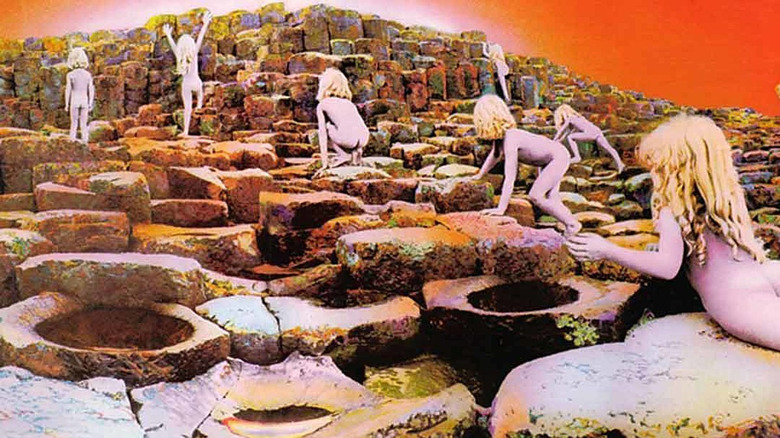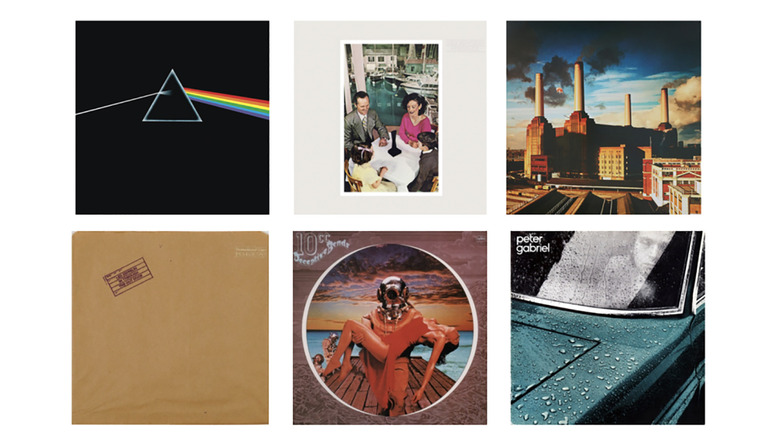

Pink Floyd's "Dark Side of the Moon" is one of the most revered rock albums of all time, and that includes the minimalist album art that adorned the original vinyl release of the 1973 record. You can find the famous triangle prism with a rainbow of color shooting out of it on a pitch-black background on posters, t-shirts, stickers, tattoos, and pretty much anything you can slap a logo on. Even people who wouldn't call themselves Pink Floyd fans are familiar with the iconic album artwork. But do you know who is responsible for creating that famous image?
Director Anton Corbijn, best known for narrative features such as "The American" starring George Clooney and "A Most Wanted Man" with Philip Seymour Hoffman, has stepped into the documentary arena with "Squaring the Circle (The Story of Hipgnosis)," which is playing at the 2023 Sundance Film Festival after premiering at the Telluride Film Festival in 2022. The film follows the foundation and rise of the design studio known as Hipgnosis, which began with the creative duo of Storm Thorgerson and Aubrey "Po" Powell and turned into a collective of artists behind some of the most famous album covers of all time, ranging from Led Zeppelin to Peter Gabriel to Paul McCartney's Wings and many more.
Of course, Corbijn is perfectly cut out for this kind of film to be his documentary debut, having directed dozens of music videos for the likes of U2, Depeche Mode, Nirvana, Metallica, and more. That's probably why he was able to wrangle the likes of Roger Waters and the surviving members of Pink Floyd, Robert Plant and Jimmy Page of Led Zeppelin, Noel Gallagher of Oasis, and even Sir Paul McCartney himself as talking heads for this occasionally acid-fueled trip through rock history.

Early on in "Squaring the Circle," Oasis co-leading man Noel Gallagher recalls a quote (though without remembering who said it) that refers to vinyl as "the poor man's art collection." While the posh people have priceless works of art on their walls, the working class people keep their precious art on the floor stacked against the wall. That treasured artwork surrounds the black vinyl discs revolutionized by Hipgnosis.
Part of Hipgnosis' rise to fame relies on the pure happenstance of Storm Thorgerson being friends with the members of Pink Floyd before the band was ever even known as Pink Floyd. But it's the unrestrained artistry of both Thorgerson (who appears only in archival footage, having passed away in 2013) and co-founder and collaborator Aubrey "Po" Powell (as the driving subject of the doc) that truly put them at the forefront of respected and revered album artwork. Combine that with the unbelievable excess of money the music industry of the 1970s was spending at the time, and you've got the perfect storm for brilliant, trippy imagery to accompany some of the greatest rock music of all time.
"Squaring the Circle" doesn't reinvent the wheel when it comes to the story's presentation. Shot mostly in beautiful black and white photography (with albums and archival footage appearing in full color), it's a standard talking head documentary with plenty of archival footage, as well as some cool, animated interstitials to introduce the album artwork being discussed. But it's the stories from the fathers (hell, they're even grandfathers now) of classic rock and roll, combined with insights from Hipgnosis, that make this a fascinating film.
You'll find out how and why a simple image of a cow in a field became instant iconography on the cover of Pink Floyd's "Atom Heart Mother" and how they lit a man on fire for "Wish You Were Here." See how composite imagery featuring two children and the practical location of the Giants Causeway in Northern Ireland was used to create Led Zeppelin's mystical "Houses of the Holy." Hear about how much effort went into flying a statuette, which Paul McCartney won in an auction, to a mountaintop in the Swiss Alps to be photographed for the cover of "Wings Greatest." Laugh about how much money was spent to photograph a sheep on a lounger on a beach in Hawaii, all so the photo could take up just a couple inches of space on the cover of 10cc's "Look Hear?" album.
They're not all instant classics though. Hipgnosis may be artists, but they were also making a living off their work. That's why not every piece of album artwork was tailor-made for the music it was meant to represent. Sometimes, Thorgerson or Powell just had a wild idea, and they decided to make it happen. In fact, there were times when they would re-pitch artwork to various bands and musicians if it was rejected by someone else. One of the funniest moments in the documentary comes when Paul McCartney learns that one of his albums used a rejected piece of artwork.

Despite being focused on the work of Hipgnosis, "Squaring the Circle" is also a love letter to the lost art of album covers. In the 1980s, alongside the changing landscape of music came a shift in the visuals that accompanied it. Suddenly album covers began to focus on the glamorous pop stars and bold fashion choices made by their stylists rather than trying to create something worthy of artistic recognition. The bands and singers of the decade graced the covers in what mostly amounted to glorified Sears portraits, making the album covers of the 1970s even more bold and unique.
At another point in the film, Noel Gallagher has another thoughtful recollection, this time lamenting the lack of love and even awareness of album artwork today. While discussing the choice of artwork for one of his own albums, his teen daughter had no concept of what album artwork even was. Having only listened to music digitally through whatever device, this young girl never came to consider the imagery that used to entice listeners to pick up an album they hadn't yet heard. To her, it was just a tiny digital image she could barely see on her screen.
Of course, the irony is that Gallagher never truly got to experience the glory of Hipgnosis himself, only because Oasis couldn't afford them. Thankfully, the rest of us could all afford their best work by having a poor man's art collection of our own, and "Squaring the Circle" celebrates that proudly and satisfyingly, even if it's not groundbreaking in the rock doc genre.
/Film Rating: 7 out of 10